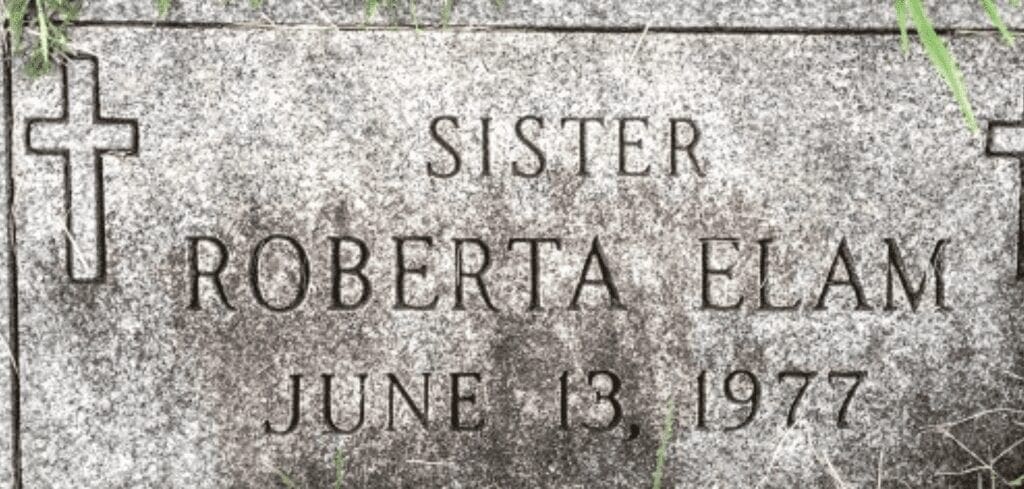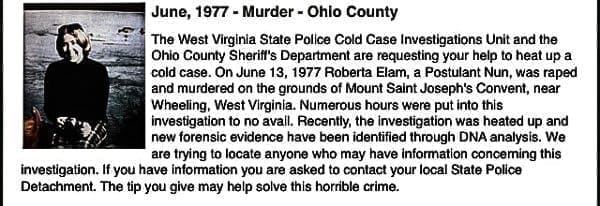Both sides of every cold case are true whether the crime took place in Ohio County or somewhere else.
Someone is dead and someone got away with it.
There are fewer than 50 cold-case files in Ohio County at this time, according to Sheriff Tom Howard, and Lt. Doug Ernest and Corp. Nicole Seifert are the two deputies who are currently in charge of managing those unsolved murders. The vast majority of the mysterious incidents took place decades ago, and that makes the task of solving them far more challenging.
“They will work on one of the cold cases we have here in Ohio County if they get a new lead,” Howard explained. “The amount of time they spend on those cases depends on what else is taking place in the county because some of the cold cases are very, very old, and they’ve taken over for former detectives who are no longer with the department. That’s one of the biggest reasons why solving cold cases can be so difficult.
“We have done some work with the case involving Sister Robin from Mount St. Joseph’s because there’s just one piece of the puzzle that remains in that case and we’ve been trying to shake something loose,” he reported. “That’s the same with a lot of our cold cases. We’re missing one small piece of the case that prevents us from solving it. That’s what makes it very frustrating for us and the people who were in these positions before us.”

A Postulant Nun – Sister Robin
Roberta Elam was 26 years old on June 13, 1977 when, while meditating on the rural grounds of the Mount St. Joseph’s Convent, she was attacked by an unknown male, raped, and then murdered in an area away from the other residents.
The facility, though, is located along Pogue’s Run Road, a two-lane street that connects GC&P Road with W.Va. Route 88, a north-south state highway that splits Oglebay Park. The crime shocked the Upper Ohio Valley community, frightened residents who lived close to the convent, and investigators fielded hundreds of calls from local residents who believed they saw something odd that could be a clue.

“There have been all sorts of leads that have been followed up on concerning the rape and murder of Sister Robin Elam that never panned out because, unfortunately, those leads were just rumors,” Howard explained. “I give the investigators credit, though, because they followed up on a lot of things that they were told. But all of them were proven to be unfounded.
“Why was the man there at the same time Sister Robin was there? I really wish I had that answer,” the sheriff said. “That murder was committed in 1977 when Sister Robin was in her mid-20s, so that makes us wonder if the perpetrator is now passed away. If that’s true, maybe we’ll never solve that case, but we hope to because it’s still about closure for the families. That’s why, when time allows, we keep pushing these cases. It’s for the families.”

Swimming with the Fishes
One aspect to the current “Big Brother” era not predicted by writer George Orwell in his 1949 book, Nineteen Eighty-Four was the smartphone. Not only are the cellular devices telephones and miniature computers, but most have a camera app and a GPS system installed pre-purchase.
Orwell was correct when predicting in the novel government-funded surveillance, but the American society has taken the practice of placing cameras far further than the author imagined. That is why, if there remains such a thing as the “perfect murder,” Sheriff Howard believes a wannabe killer would have a much more difficult time attempting to commit such a crime these days.
“There are thousands of murder cases that have taken place throughout the United States that likely will never be solved. Do you call those cases perfect murders? Was the murder of Sister Robin the perfect murder? I can’t answer that question,” Howard insisted. “But now we have access to so much more than what those investigators in the 1970s didn’t have that we have now. We have DNA, and we have cameras everywhere.
“That’s why I don’t know if it’s possible anymore to get away with murder,” he said. “I believe most people most of the time do not realize they are on camera. A lot of cases are solved by what has been caught on cameras. If you think about it, it’s tough to go anywhere without being on someone’s camera whether it’s a business or a house camera. Plus, people are very quick to pull out their cell phones.”

The Boast and the Bust – Leo Lanci Cold Case
Former Marshall County Sheriff John Gruzinksas still believes one of these days someone who knows what actually happened to Leo Lanci in early 2008 will slip up.
Lanci’s remains were discovered by a teenager in a wooded area near Round Bottom Road. What the boy found was a human skeleton wearing clothes. Lanci was 21 years old at the time of his death and a diamond ring and a not-yet-activated were found in his pockets. His skull, investigators found, rested face up only a few inches from a stream that trickled through the holler.
But why Lanci was so deep in that wooded area, and why he traveled from New York to Cambridge and to Marshall County all are unknowns. But Howard agrees with Gruzinksas. Someone knows something and just may reveal too much.

“That’s because bragging is a huge part of cold case investigations,” Howard said. “When someone finally says something to someone, it usually leads to that last piece of the puzzle. Sometimes, someone will say something to someone and that’s how it gets out and eventually reaches someone in law enforcement. When that happens, it opens something up.
“When you are in law enforcement and you have a case that’s pretty complex, you just never know where the big break is going to come from. But I can tell you, every possible lead gets check out,” the sheriff insisted. “Most often, there are no results, but there are those times when it cracks a case and that’s why everything will always be checked out.”
Howard doesn’t know if a single cold case will be solved during his second and final term as Ohio County sheriff, but if one is, he’ll claim no credit.
“Listen, if one of our cold cases does get solved while I am the sheriff, the credit will not come to me but instead to our detectives and to all of the past detectives,” he insisted. “If one of those cases gets cracked, it will be because of them.”
Best of 2020: Suicide? No Way – Part 1
Cold Case – Leo Lanci – Marshall County


